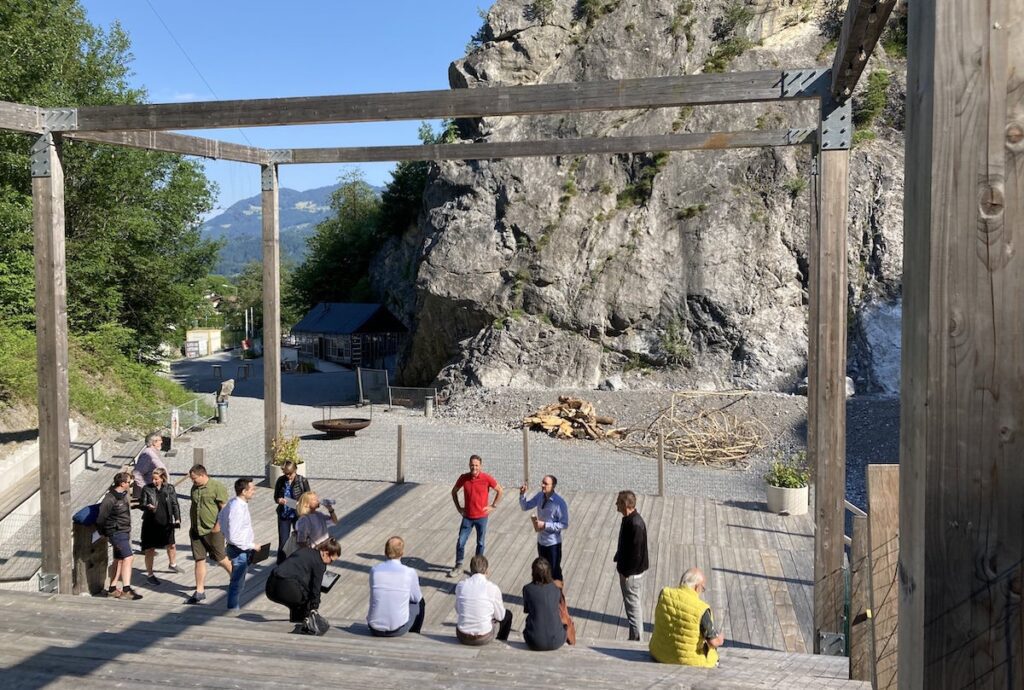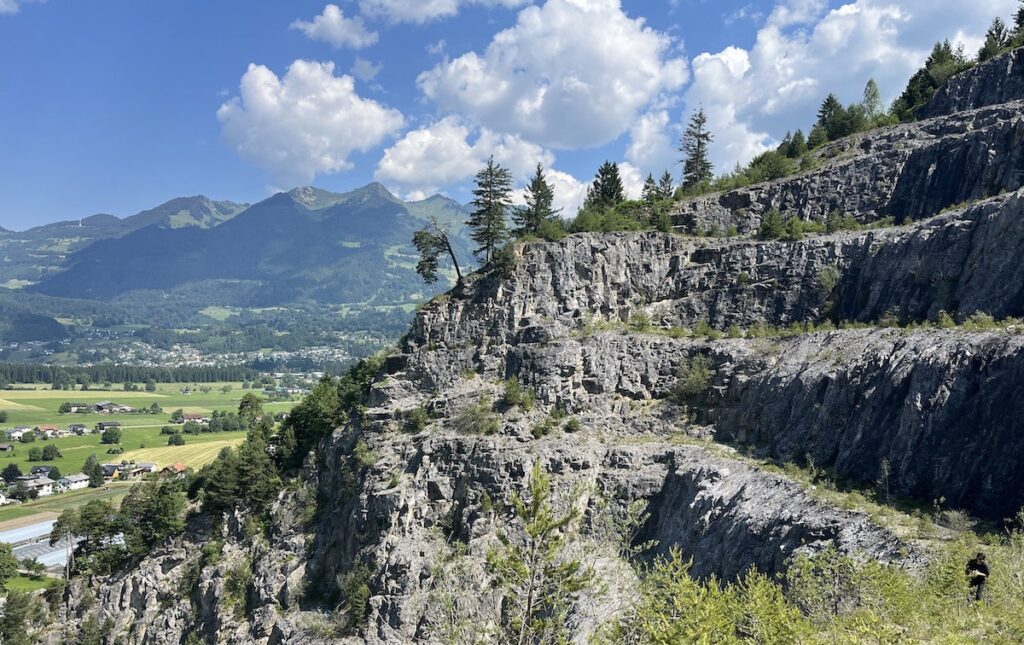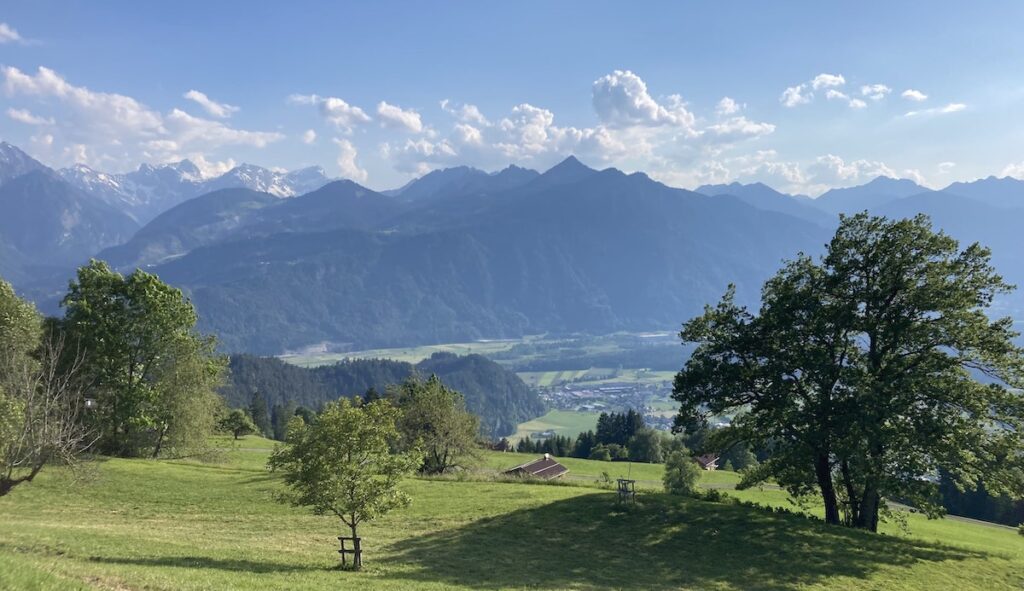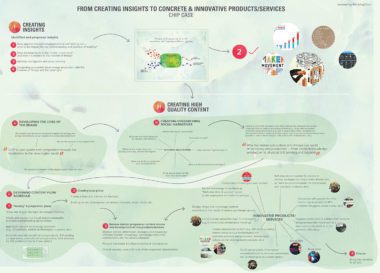Author: Lena Müller-Naendrup
We have recently been working on a stimulating project in the mountainous Austrian region of Vorarlberg. Alongside the dedicated local team in Ludesch, the small town located at the entrance gate to the serene Walgau valley, we have embarked on the transformation of a disused quarry.
Our mission? To uncover fresh possibilities for repurposing the quarry that will make a long-lasting, sustainable impact on the local community. In this blog post, we delve into the practicality and benefits of repurposing old industrial sites, while also addressing the challenges we have faced and the lessons we have learned from our ongoing project in Vorarlberg.
The Abandoned Heritage
Abandoned industrial sites ranging from disused mines, empty dockyards, and deserted factories to run-down mills are not just present in Vorarlberg. They can be found all across the world. While some view them as symbolic of past communities and iconic sites worth preserving, others perceive them as scars on the landscape. However, regardless of personal perception, neglected sites pose economic and environmental burdens on neighboring communities.
This is not only aesthetically unpleasing but wastes building land. Cities are struggling to accommodate the increasing demands of housing, especially affordable housing. The scarcity of space as well as the climate crisis, make re-densification an imperative step toward a more sustainable future. In this context, considering existing vacant buildings and sites becomes crucial for addressing these challenges.
Old ideas can sometimes use new buildings. New ideas must use old buildings.
Jane Jacobs
According to Ruth Lang, architect and professor of architecture at the Royal College of Art in London, 80% of buildings projected to exist in 2050 are already built. This statistic emphasizes the need to shift our focus from solely constructing new buildings to repurposing existing structures. By doing so, we can substantially reduce the embodied energy associated with the construction sector.
Embodied energy refers to the total energy and carbon emissions linked with extracting materials, transporting them to the construction site, building the new structure, maintaining it, and eventually demolishing it. Thus, repurposing existing buildings instead of demolishing them to make way for new constructions can save a significant percentage of embodied energy. In fact, as the 2018 president of the AIA phrased it: “The greenest building is the one already standing”.
Designing for Life Cycles and Reuse
Sustainable architecture goes beyond reducing emissions in the present; it begins with a forward-looking approach, designing for longer life cycles. Unfortunately, many of our constructions today lack consideration for the dimensions of their longevity. It is challenging to grasp the far-reaching time frames of the structures we built, as their long-term impact may not be immediately visible.
Take old factories, mills, and disused mines as examples, vividly illustrating the outdatedness of once purposeful buildings. These industrial structures, once vital for local economies and communities, have now been abandoned or underutilized due to shifts in industries and technological advancements.

While their original purposes have faded away, the buildings and materials endure. So when trying to expand the life cycles of abandoned structures, we have come to notice that there are two key goals which repurposing projects should aim to achieve:
- Reintroducing Purposefulness: We must reimagine and transform neglected structures, taking into consideration the current social, economic, environmental needs and identify new usages. By repurposing them to serve future (emerging) requirements and aspirations?, we breathe new life into these spaces, making them more relevant and valuable.
- Building for Timelessness: Our goal should be to renovate or rebuild these sites to allow for adaptability over time, catering to a diverse range of future programs and needs. We can ensure that these spaces evolve alongside changing circumstances by designing with flexibility and versatility.
So, how can we achieve this transformation? How can we effectively revive the purpose of an old site or building, ensuring its relevance for future generations? The key lies in responding to the past and present while building for the future.
First Explore, Then Design!
Embracing the challenge of working with existing buildings or sites requires a departure from conventional design methods. Unlike starting from a blank slate, crafting a reuse strategy demands a more humble and empathic design process. Rather than imposing an entirely new vision, it’s about recognizing and responding to the inherent qualities of what already exists.

While some may perceive developing reuse concepts as creatively limiting, it’s a process of unveiling hidden potentials and igniting a new creative spark. It’s about breathing new life into a building, integrating contemporary demands while respectfully preserving its unique identity and character. It’s a bridge-building process, seamlessly connecting the future with the old and the present.
Achieving this requires a patient exploration of the structure’s essence, as well as an understanding of its social and cultural significance within the local community. It’s about acknowledging the physical elements and embracing the emotional and historical threads woven into the fabric of the site. Integrating the old into the new demands a meticulous and thoughtful approach – the strategy underpinning often outweighs the initial ideas behind the design itself.
Sneak Preview in Ludesch: Unveiling a Quarry’s Potential
Our project in Vorarlberg, during which we were tasked with developing future-proof concepts and ideas for an abandoned quarry, started without a predetermined vision. Instead, an explorative phase has been dedicated to unraveling the quarry’s latent potentials and collectively shaping a fresh concept for its future.
The project’s kick-off in November 2022 marked a vibrant prelude as the quarry opened its doors to the public, hosting a series of cultural and social events throughout the year. This unique opportunity allowed the local community to experience the quarry beyond its industrial legacy, viewing it in a new light.

Simultaneously, we carefully explored the quarry and its surroundings to uncover its inherent attributes and untapped potentials. Through conversations with neighbors, ethnographical on-site studies, and in-depth interviews with multidisciplinary experts, we discovered specific qualities and potentials that were previously unnoticed.
This thorough exploration led us – through a sense-making process – to pinpoint three distinct future topic fields. Each of the three defined topic fields revolves around a unique core quality and potential, namely:
- Usage diversity of the vertical
- Perceiving neglected places as potentials
- Quarry as an ecosystem for the future
These three prospective topics served as the blueprint for the next phase in the process, a collaborative two-day workshop involving approximately 25 key stakeholders. To start with, these stakeholders were introduced to the quarry’s characteristics during an on-site inspection, allowing them to experience its qualities firsthand.
Subsequently, we divided the stakeholders into three groups, corresponding to the three identified prospective topics. During this process, the workshop participants jointly worked on concrete ideas responding to the previously identified characteristics and potentials of the quarry, both in its historical context and its current and future prospects. This approach aimed to cultivate concepts and ideas that emanate from the core of the quarry, reflecting an inside-out perspective.
For a deeper insight into our project’s details and the quarry’s transformation, we invite you to continue reading the project’s story, which we will release soon!
First Lessons Learned
Even though our journey in Vorarlberg is not yet finished, it has already offered us invaluable insights into the world of adaptive reuse. Our exploration of repurposing old, abandoned industrial sites brought forth the following take-away messages:
- Innovation beyond creation: Innovation isn’t always synonymous with creating anew. The revitalization of existing structures demands a unique blend of imaginative thinking, negotiation, and a deep appreciation for the interplay between legacy and the future.
- Propelling sustainability through extended lifecycles: Addressing the environmental crisis requires us to embrace temporal perspectives beyond our immediate time frame. Instead of always building anew, breathing new life into the old saves a lot of embodied energy and is a compelling pathway toward a more sustainable future. New concepts should not be limited to the demands of the present, but should remain flexible and adaptable so that their life cycles extend into the future.
- Don’t forget about the past: What might seem purposeless now has probably once added significant value to the local community and industry. By connecting the historical significance with the present needs, we can create meaningful progress that resonates with regional aspirations and economic value..
- The art of deliberate transformation: Repurposing projects don’t begin with visionary concepts but develop from a patient immersion into the fabric of existing structures. By carefully exploring materiality, social significance, and cultural identity, we can unlock the blueprint for a purposeful future.
- Join forces: Journeys of adaptive reuses thrive on collaboration. Engaging diverse stakeholders, particularly the local community, reveals invaluable insights and associations that breathe life into spaces and amplify their impact. It’s important to note that collaboration in this sense goes beyond exchanging ideas and finding compromises. It boils down to creating a shared understanding of what a place and community need and desire and supporting this understanding jointly throughout the process.
As we continue to shape the on-going story of the transformation of the quarry in Ludesch, the insights we have gained thus far serve as guiding lights towards a more sustainable, purposeful, and harmonious built environment.
If you are inspired to embark on a repurposing project or curious to learn more about our approach, we encourage you to reach out. Together, we can propel innovation without starting from scratch and contribute to a more sustainable future for our built environment.
Subscribe to Our Newsletter
Keep your innovative edge with more stories like this and additional reading tips, muses, and project updates.
References
- Gestalten, Lang, R., Flanagan, R., & Klanten, R. (2022). Building for Change: The Architecture of Creative Reuse. Gestalten.


